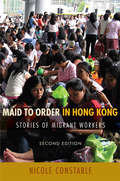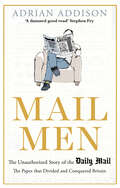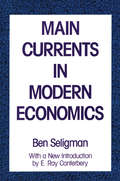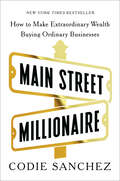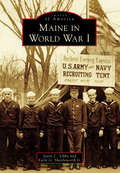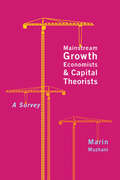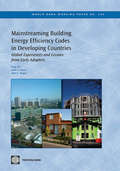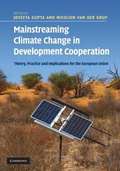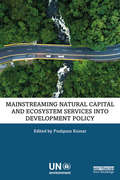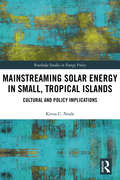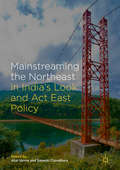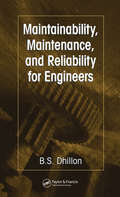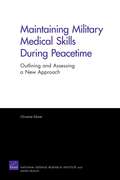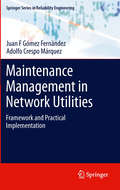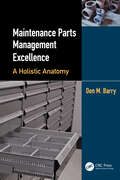- Table View
- List View
Magpie: Developing and Using Buyer Personas
by Frank V. CespedesThe founders of a start-up platform for publishers have developed preliminary personas of target customers, and are evaluating the implications for initial target buyers, messaging, and marketing programs.
Mahindra & Mahindra: Creating Scorpio
by Tarun Khanna Rajiv Lal Merlina ManocaranDetails the emergence of a private sector automobile manufacturer in India that has created globally competitive and cheap versions of an SUV commonly available worldwide. Asks us to think about the parent corporation's next steps in leveraging this success. In particular: To what extent does it make sense to expand overseas vs. entrenching itself within the home market--India?
Mahindra & Mahindra: Leveraging India's Size for Global Scale in Tractors--A Profile of One of India's Pioneering Multinationals
by Nirmalya Kumar Pradipta K. Mohapatra Suj ChandrasekharMahindra & Mahindra started in 1945 at the dawn of Indian independence and has since transformed from a steel trader, to an assembler of Jeeps from kits imported from the U.S., to a multifaceted business with a global presence in eight key sectors and global revenue in 2008 of $6.7 billion. This chapter focuses on M&M's two largest businesses--automotive and farm equipment, tracing the company's sometimes rocky journey to becoming a global powerhouse. This chapter is excerpted from "India's Global Powerhouses: How They Are Taking on the World."
Mahindra Lifespace Developers' Venture into Affordable Housing
by Joseph Fuller Vidhya MuthuramCase
Maid to Order in Hong Kong: Stories of Migrant Workers, Second Edition
by Nicole ConstableMiddle-class Chinese women in the global city of Hong Kong have entered the workforce in unprecedented numbers over the past three decades, and the demand for foreign domestic workers has soared. A decade ago some foretold the decline in foreign workers and the influx of mainland workers. But today over 120,000 women from the Philippines, over 90,000 from Indonesia, and thousands more from other parts of South and Southeast Asia serve as maids on two-year contracts in Hong Kong, sending much needed remittances to their families abroad. Nicole Constable tells their story by updating Maid to Order in Hong Kong with a focus on the major changes that have taken place since Hong Kong's reunification with mainland China in 1997, the Asian financial crisis of the late 1990s, and the outbreak of SARS in 2002-2003. Interweaving her analysis with the women's individual stories, she shows how power is expressed in the day-to-day lives of Filipina domestic workers and more-recent Indonesian arrivals.
Mail Men: The Unauthorized Story of the Daily Mail
by Adrian AddisonDiscover the secret history of the paper that has shaped Britain and taken over the world. Perhaps because of the power and fear that the Daily Mail commands, this is the first book to provide an unauthorized account of the newspaper with more global readers than any other. With a gripping personality-led narrative, informed by sources near the top of the paper, Mail Men investigates the secret behind the Mail's extraordinary longevity and commercial success. But, it also examines the controversies that have beset the paper—from its owner's flirtation with fascism in the 1930s to its fractious relationship with liberals, celebrities and politicians today. Asking why the Mail attracts such anger around the world, Addison explores how insiders view the furore the paper creates both in its print and online incarnation. He also uses his numerous contacts to ask how the paper has stayed relevant for over a century. How has MailOnline built such a huge global audience by focussing on celebrity gossip, in apparent tension with the sometimes puritanical values of its sister print edition? Gripping and revealing, this book gives a previously unseen insight into the colorful cast of senior MailMen (yes, nearly all men) who have molded the paper through the decades—from Alfred C. Harmsworth, the Mail's founder and first owner, a frenetic genius who invented the popular press as we know it, to Martin Clarke, the fearsome Scot who runs MailOnline, the most popular newspaper website in the world.
Mailchimp Pour Les Débutants: Le Guide Du Marketing Par Email Pour Les Auteurs Indépendants
by Leslie Pierobon Adam NetherlundEn tant qu'auteur indépendant, vous avez peut-être entendu parler des newsletters et songé à en créer une. Mais comment s'y prendre ? De nos jours, il existe énormément de possibilités -- AWeber, Constant Contact, iContact, Vertical Response et tant d'autres -- mais l'une des plus populaires est MailChimp.Si vous avez déjà pensé à essayer MailChimp mais ne saviez pas vraiment par où commencer, ce livre est pour vous. Suivez de simples instructions étape par étape qui vont vous aider à facilement envoyer votre première campagne et à entrer en contact avec vos fans.Dans ce court guide conçu pour ceux qui débutent avec MailChimp, vous découvrirez :- comment créer un compte ainsi que votre première liste ;- comment créer différents types de formulaires d'inscription ;- comment créer votre première campagne ;- comment analyser les statistiques ;- des idées pour créer votre mailing list (spécifiques à l'auto-édition) ;- des conseils généraux et les choses à faire/ne pas faire lors de la création de vos campagnes ;- les possibilités offertes par les plugins Wordpress, les applications mobiles, les formulaires pour tablettes et pour Facebook.Le marketing par e-mail n'est ni difficile ni onéreux, alors détendez-vous et commençons à vous ouvrir à de nouvelles compétences.
Main Currents in Modern Economics: Economic Thought Since 1870
by Ben B. SeligmanMain Currents in Modem Economics deserves to be the classic it is. At the time of its original publication in 1962, Ben Seligman, a scholar’s scholar, had immersed himself in the development of economic thought since 1870. This product of his efforts is truly timeless. Why is Main Currents still modern and surprisingly up-to-date? For Seligman, the story begins with the revolt of German historical writers against the rigidity of classical doctrine, a natural starting point for contemporary theory. He takes us from the world of Thorstein Veblen to Galbraith’s theory of countervailing power and the affluent society—worlds that he makes us understand are not so far apart., Seligman also shows us how the doctrines begin to repeat themselves. Tradition is reaffirmed with the rediscovery of marginalism by Jevons, the Austrians, and J. B. Clark. A more neutral version of “equilibrium economics” is supplied by Leon Walras and Vilfredo Pareto, a main current of thought extended by John R. Hicks and Paul A. Samuelson. Seligman characterizes the principal trait of modern doctrine as the use of technique for its own sake. Dismissing G.L.S. Shackle’s writing on uncertainty, he criticizes Shackle’s use of continuous rather than discontinuous function., Main Currents may have been published too soon to be fully appreciated. Selig-man’s focus on the thrust toward technique now has a ring of truth that can no longer be ignored. As Ray Canterbery notes in his introduction, in some respects only the names of the players have changed, and Main Currents’ pertinence to today’s issues is self-evident. Economics has moved so deeply into technique that the next generation may have to rediscover the past in order to find its way out. Seligman s book is a good place to begin the journey.
Main Street Millionaire: How to Make Extraordinary Wealth Buying Ordinary Businesses
by Codie SanchezRich people know a secret. In this book, former Wall Street investor Codie Sanchez pulls back the curtain.Most people look for wealth in all the wrong places. From dropshipping and startups to grinding for promotions, you might believe you have to trade your life to be one of the few who win. But the truly rich know these paths are paved with delusion and false promises.In Main Street Millionaire, Codie Sanchez teaches you the path the wealthy really walk. Instead of risking it all with little chance of success, she shows you how to acquire cash-flowing businesses that are winning right now. Sanchez, one of the world&’s leading small business experts, reveals the dealmaking framework she&’s taught to tens of thousands, and that she&’s used to build her own 9-figure holding company. Her secret? She acquires overlooked &“Main Street&” businesses. We&’re talking about the unsexy but reliably profitable industries — like plumbing, construction, cleaning, electrical — that white collar workers have overlooked.In this book, you&’ll see practical strategies and step by step processes to acquire cash flow and freedom. You&’ll meet humans just like you who have changed their life through ownership. You will learn: Why today&’s market is ripe for generational wealth creation How to identify and close amazing business deals, without being wealthyHow to 10x your growth after acquiring a small businessThe 7 businesses you should never buy, and whyHow to own multiple businesses at once (without losing your mind)Main Street Millionaire will reshape the way you think about your wealth and ownership forever. However, it&’s not for slackers. It&’s for those who want meaning and fulfillment while building their community. Codie's no-BS, out-of-the-box wisdom is the antidote to a complacent life of making other people rich. In summary: Your money, and meaning, is on Main Street.
Maine in World War I (Images of America)
by Earle G. Shettleworth Jr. Jason C. LibbyWith the same patriotic fervor as Maine�s response to a call for troops in the Civil War, more than 35,000 men and women across the state joined the armed forces in 1917�1918 to fight in aid of America�s European allies against Germany, as well as to redress German destruction of American vessels in the North Atlantic. Mainers also provided vital support to the United States and the Allies through war-related industries, like shipbuilding, munitions, textiles, and agriculture, while purchasing more than $100 million in war bonds and donating bandages, books, and other comforts of home to the troops. The war may have been �over there,� but its effects were found throughout the state of Maine.
Mainstream Growth Economists and Capital Theorists
by Marin MuzhaniMainstream Growth Economists and Capital Theorists provides a historical survey and ideal introduction to modern economics, arguing that due to significant changes in recent years, a re-evaluation is in order. Marin Muzhani presents an informed study of the debates regarding economic growth and development that began in the 1930s in response to the Great Depression. He argues that in the wake of that crisis, the challenge for economists was to understand how to generate stable economic growth in order to prevent future crises. The theories of John Maynard Keynes, in particular, sought to explain the reasons for unemployment and recessions, paving the way for the field of macroeconomics and challenging the basic premises of neoclassical economics. In the late 1930s and 1940s, economists began to extend Keynes' ideas, synthesizing them with neoclassical ideas in order to explain economic growth. This "neoclassical synthesis" would dominate mainstream macroeconomic thought for the next forty years until the mid-1980s with the introduction of endogenous growth theories. Taking into account the historical background, the multitude of interpretations of modern growth models, and the geography of mainstream economists, Mainstream Growth Economists and Capital Theorists will simplify the structure of growth theory for the next generation of economists.
Mainstream Growth Economists and Capital Theorists: A Survey
by Marin MuzhaniMainstream Growth Economists and Capital Theorists provides a historical survey and ideal introduction to modern economics, arguing that due to significant changes in recent years, a re-evaluation is in order. Marin Muzhani presents an informed study of the debates regarding economic growth and development that began in the 1930s in response to the Great Depression. He argues that in the wake of that crisis, the challenge for economists was to understand how to generate stable economic growth in order to prevent future crises. The theories of John Maynard Keynes, in particular, sought to explain the reasons for unemployment and recessions, paving the way for the field of macroeconomics and challenging the basic premises of neoclassical economics. In the late 1930s and 1940s, economists began to extend Keynes' ideas, synthesizing them with neoclassical ideas in order to explain economic growth. This "neoclassical synthesis" would dominate mainstream macroeconomic thought for the next forty years until the mid-1980s with the introduction of endogenous growth theories. Taking into account the historical background, the multitude of interpretations of modern growth models, and the geography of mainstream economists, Mainstream Growth Economists and Capital Theorists will simplify the structure of growth theory for the next generation of economists.
Mainstreaming Building Energy Efficiency Codes in Developing Countries
by Anke S. Meyer Feng Liu John F. HoganUrbanization and growing wealth in developing countries portend a large increase of demand for modern energy services in residential, commercial and public-service buildings in the coming decades. Pursuing energy efficiency in buildings is vital to energy security in developing countries and is identified by the Intergovernment Panel on Climate Change as having the greatest potential for cost-effective reduction of CO2 emissions by 2030 among all energy-consuming sectors. Building energy efficiency codes (BEECs), along with energy efficiency standards for major appliances and equipment, are broadly recognized as a necessary government intervention to overcome persistent market barriers to capturing the economic potential of energy efficiency gains in the residential, commercial and public-service sectors. Implementation of BEECs help prevent costly energy wastes over the lifecycles of buildings in space heating, air conditioning, lighting, and other energy service requirements. Nonetheless, achieving the full potential of energy savings afforded by more energy-efficient buildings requires holding people who live or work in buildings accountable for the cost of energy services. Compliance enforcement has been the biggest challenge to implementing BEECs. This report summarizes the findings of an extensive literature survey of the experiences of implementing BEECs in developed countries, as well as those from case studies of China, Egypt, India, and Mexico. It also serves as a primer on the basic features and contents of BEECs and the commonly adopted compliance and enforcement approaches. This report highlights the key challenges to improving compliance enforcement in developing countries, including government commitment to energy efficiency, the effectiveness of government oversight of the construction sector, the compliance capacity of building supply chain, and financing constraints. The report notes that the process of transforming a country's building supply chain toward delivering increasingly more energy-efficient buildings takes time and requires persistent government intervention through uniformly enforced and regularly updated BEECs. The report recommends increased international support in strengthening the enforcement infrastructure for BEECs in middle-income developing countries. For low- and lower-middle-income countries, there is an urgent need to assist in improving the effectiveness of government oversight system for building construction, laying the foundation for the system to also cover BEECs.
Mainstreaming Climate Change in Development Cooperation
by Joyeeta Gupta Nicolien van der GrijpClimate change, development and development cooperation are, individually and jointly, three politically sensitive, complex issues, especially in the context of relations between developed and developing countries. This book tackles these issues by combining theoretical, political, and practical perspectives, analysing the dominant paradigms and exploring the meaning of the concept of mainstreaming. At the practical level, it presents the results of case studies focusing on assistance provided by the European Union and key member states and the climate needs articulated by developing countries. At the political level, it highlights the sensitivities between developed and developing countries and examines the mainstreaming debate in various fora. This book is valuable for policymakers, academics, politicians and non-state actors working in the fields of development studies, international law, politics, international relations, economics, climate change, and environmental studies.
Mainstreaming Natural Capital and Ecosystem Services into Development Policy
by Pushpam KumarThis book highlights the latest advances in the science and practice of using ecosystem services to inform decisions for economic development in the context of the developing countries. The development of the ecosystem services paradigm has enhanced our understanding of natural capital as an indispensable form of capital asset along with produced and human capital. This book addresses what could be the possible pathways to mainstream natural capital assets into development policies and what is currently known about the economic values of ecosystem services. A series of innovative tools to help policy makers and planners account for natural capital and ecosystem services in sectoral and macroeconomic policies have been explored and their application at the national and regional scale has been demonstrated. Several detailed case studies are presented in which the understanding of ecosystem services values has successfully informed decisions, including examples from Chile, South Africa, Tanzania, Trinidad and Tobago, Vietnam and the Aral Sea in Central Asia. These provide the critically important insights, lessons learned and means and mechanisms for policy makers to incentivize protection and discourage degradation of ecosystems and the services they provide. Mainstreaming Natural Capital and Ecosystem Services into Development Policy is designed to help decision makers at all levels, including governments, businesses, multilevel development banks and individuals to integrate ecosystems and their services into their decision making.
Mainstreaming Solar Energy in Small, Tropical Islands: Cultural and Policy Implications (Routledge Studies in Energy Policy)
by Kiron C. NealeThis book explores how cultural considerations can improve policymaking to achieve mainstream solar energy in small, tropical islands. Focusing on Trinidad, Barbados and Oʻahu, Kiron C. Neale looks at how culture can affect and be affected by the policies that support the household adoption of two key energy technologies: solar water heating and photovoltaics. Drawing on interviews with residents and energy officials, and an examination of the institutional, socio-economic and physical factors that affect energy systems such as governance structures and energy resource availability, the author explores themes including the impact of insularity on energy transitions and behavioural and cultural change. Overall, this book rebrands policies as instruments of cultural change and puts forward recommendations applicable to all small, tropical islands. Following the islands’ transition to renewable energy, this book will be of great interest to scholars of energy policy, energy transitions, climate change, cultural studies and small states development, as well as industry professionals working on energy policy implementation.
Mainstreaming the Northeast in India’s Look and Act East Policy
by Atul Sarma Saswati ChoudhuryThis book provides a detailed account of the evolution of India's Look and Act East Policy, addressing the nuances of the policy and its efficacy for the Northeast Region. The Northeastern India as a region is landlocked, sharing most of its boundary with neighbouring countries of South and South East Asia. It empirically explores the progress in and prospects for trade, investment and connectivity between Northeast India and Southeast Asian countries. Further, it discusses a range of regional and sub-regional multilateral initiatives - e. g. the Bay of Bengal Initiative for Multi-Sectoral Technical and Economic Cooperation (BIMSTEC), Bangladesh-China-India-Myanmar (BCIM), and Mekong-Ganga Cooperation (MGC) - that could potentially strengthen the cooperation between Northeast India and neighboring regions in the social, cultural and economic spheres.
Maintainability, Maintenance, and Reliability for Engineers
by B.S. DhillonThe demands of the global economy require manufacturers to produce highly reliable and easily maintainable engineering products. Recent studies indicate that for many large and sophisticated products or systems, maintenance, and support account for as much as 60 to 75 percent of their life cycle costs. Therefore, the role of maintainability, mainte
Maintaining Military Medical Skills During Peacetime
by Christine EibnerMilitary medical personnel are tasked with fulfilling both the benefits mission and the readiness mission of the U.S. Department of Defense (DoD). However, the medical skills required during deployment are likely to differ significantly from those required during peacetime. This study explored an arrangement in which some personnel are stationed in nonmilitary settings where the case mix might more closely resemble that expected under deployment.
Maintenance Management in Network Utilities
by Adolfo Crespo Márquez Juan F Gómez FernándezIn order to satisfy the needs of their customers, network utilities require specially developed maintenance management capabilities. Maintenance Management information systems are essential to ensure control, gain knowledge and improve-decision making in companies dealing with network infrastructure, such as distribution of gas, water, electricity and telecommunications. Maintenance Management in Network Utilities studies specified characteristics of maintenance management in this sector to offer a practical approach to defining and implementing the best management practices and suitable frameworks. Divided into three major sections, Maintenance Management in Network Utilities defines a series of stages which can be followed to manage maintenance frameworks properly. Different case studies provide detailed descriptions which illustrate the experience in real company situations. An introduction to the concepts is followed by main sections including: * A Literature Review: covering the basic concepts and models needed for framework design, development and implementation. * Framework Design and Definition: developing the basic pillars of network utilities maintenance management framework. * Performance Evaluation & Maturity: focusing on the reliability concept and maturity models from different viewpoints. By establishing basic foundations for creating and maintaining maintenance managements strategies, Maintenance Management in Network Utilities acts a practical handbook for all professionals in these companies and across areas such as network development, operations management and marketing.
Maintenance Parts Management Excellence: A Holistic Anatomy
by Don M. BarryMost successful organizations recognize Maintenance Parts and Procurement as a critical success factor to Asset Management Excellence and their fundamental supply chain value proposition. This book works as a guide to all the stakeholders that influence the success of their Maintenance Parts Operation and their enterprise’s bottom line. Maintenance Parts Management Excellence: A Holistic Anatomy defines the Maintenance Parts Managements role in Asset Management Excellence and expands on the importance of the Parts Inventory Planner role in an organization. It discusses how to create a unique Maintenance Parts Management Strategy for an organization and offers insights on the multiple strategies needed to create and maintain a Maintenance Parts inventory policy. The book also provides an organized overall approach to creating Maintenance Parts Management Excellence in an enterprise. Executives with an organization responsible for the construction, management, and disposal of all assets classes (plant, equipment, IT assets), consultants responsible for assignments associated with optimizing life cycle decisions for clients, maintenance, and reliability professionals within an organization, will benefit from this professional plus book. Upper-level undergraduate engineering students, as well as graduate students of management who focus on operations management and engineering graduate students addressing issues of maintenance and reliability engineering, may also be interested in this book.
Mais de 100 Dicas para Melhorar sua Vida Profissional - Ética Profissional
by Richard G Lowe Jr Vanisse Vaz FernandesDecole sua carreira sem sacrificar sua ética e integridade E se você pudesse ser bem sucedido em sua carreira? Imagine que com alguns passos simples você poderia realmente começar a desfrutar do seu trabalho, voltar para casa renovado e aumentar o seu salário? E se você pudesse fazer tudo isso sem ser um bajulador do chefe ou sacrificar sua integridade e vida pessoal? Líder corporativo e gerente por mais de 30 anos, Richard Lowe, apresenta algumas das lições que ele aprendeu gerenciando centenas de pessoas e liderando equipes felizes e realizadas. Lowe responde à pergunta: Como você pode melhorar seu trabalho, melhorar sua carreira, ganhar mais dinheiro, e ainda assim levar uma vida feliz fora do trabalho? Neste livro, você aprenderá: Como obter o respeito de seus companheiros de equipe O que é preciso para ser visto como um líder eficaz Como lidar com as “maçãs podres” no local de trabalho Por que as reuniões são desnecessárias a menos que sejam cuidadosamente gerenciadas O que fazer sobre os e-mails black-hole e o tempo perdido Por que os gestores amam prazos e como controlá-los Por que sua integridade é a mercadoria mais importante que você possui Como separar o trabalho e a vida pessoal, e manter os dois, mesmo se o chefe quiser que você trabalhe até a morte Ouça agora para aumentar sua produtividade, melhorar sua carreira e ganhar mais dinheiro!
Maison Bouygues
by John A. Quelch Greg ConleyThe vice president of marketing is reviewing the 1991 marketing plan and budget for Maison Bouygues, the leading builder of new single family homes in France. Due to recession, the company's sales are forecast to be flat and adjustments may need to be made in the marketing and selling mix.
Maize In The Third World
by Christopher DowswellMaize is the world's most widely grown cereal and a dietary staple throughout the Third World, but its full potential has only begun to be tapped. This book thoroughly examines the biological and economic issues relevant to improving the productivity of maize in developing countries. The authors explore a wide range of practical problems, from maxi
Majid Al Futtaim Retail Geographic Expansion: Brick or Click?
by Juan Alcacer Alpana ThaparThis case illustrates the challenges that retailers face when they aggressively pursue geographical growth by expanding both their physical store network and their online presence. It features Majid Al Futtaim (MAF) Retail, a franchisee of Carrefour hypermarkets in the Middle East, Africa, and Asia, a company that strived to strike the right balance of offline and online for each of the markets it served. MAF Retail had a strong presence in the Middle East, particularly in its home market, the United Arab Emirates, and it had been building its presence in Egypt, Pakistan, Kenya, Georgia, and most recently in Uganda. There were also opportunities to open hundreds more stores in each of these markets and expand into 15 other countries in Asia and Africa where it had a license. But the retail environment was changing across the globe, owing to a shift in consumer behaviors that accompanied the rise of the online-only players. CEO Hani Weiss had been driving a digital transformation within the company, building the necessary technology and online capabilities to provide a seamless experience to its customers. The company also partnered with online-only players to increase its reach to customers in countries where MAF Retail had a presence and to provide an online offer to customers where it had no online store. Going forward, Weiss faced hard choices in deciding which markets to prioritize. He also had to determine the right balance of offline and online for each market. Should he invest his resources in opening new stores, or in building online capabilities-or both? How would his strategy differ in the key markets?

